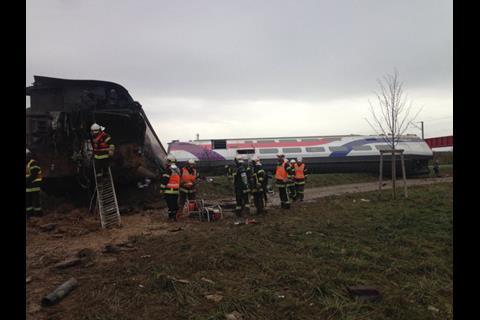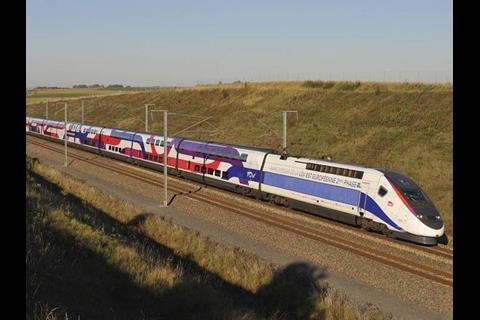FRANCE: Opening of the 106 km second section of LGV Est-Européenne between Baudrecourt and Vendenheim for commercial services is likely to be delayed, following the high speed derailment of a TGV test train on November 14. SNCF Réseau President Jacques Rapoport told local media that it was ‘reasonable to expect’ that the April 3 2016 opening date would be postponed.
Instrumented TGV 2N2 EuroDuplex set 744, which had been undertaking commissioning tests on the new line since September, left the tracks at high speed on a curve near Eckwersheim, shortly before the junction at Vendenheim about 12 km north of Strasbourg. Around 50 people were thought to be on board, of which 11 are confirmed killed and 37 injured, including 12 seriously hurt. The train was reported to be carrying unauthorised guests including children, who were understood to be family and friends of the test team.
Around 15.10 on Saturday afternoon, the TGV had been travelling towards Strasbourg on the southern track, which will mainly be used by westbound services. It overturned on a curved embankment before striking the parapet of a bridge over the Marne-Rhine canal. The vehicles were flung into adjacent farmland and the rear power car ended up in the water. Three enquiries are in progress to determine the cause of the derailment.
Dominique-Nicolas Jane, Head of the Office of the Alsace Préfet, said the train had ‘derailed because of excessive speed’. The commissioning programme for the new line includes 200 overspeed test runs at 10% above the 320 km/h line speed, which is a standard procedure. SNCF Réseau Vice-President Claude Solard said the test train should have slowed from 352 km/h to 176 km/h before crossing the canal; the curve leading to the flying junction with the existing line has a radius of around 1 000 m.
SNCF President Guillaume Pepy insisted that it was too early to ascertain the cause of the accident, adding that SNCF had not yet been given access to the ‘black box’ data recorders or witness statements from the two drivers. However, he confirmed that ‘some automatic safety systems’ had not been in use during the test running.
The accident mars the excellent safety record of the TGV, which stretches back to the launch of commercial services on LGV Sud-Est in 1981. There were no fatalities or serious injuries when a TGV derailed at nearly 300 km/h near Ablaincourt-Pressoir on LGV Nord-Europe on December 21 1993 because of an undetected void below the tracks that collapsed after heavy rain. Nor was anyone hurt on an Annecy – Paris TGV when one bogie derailed as the train was passing through Mâcon-Loché station at 270 km/h on December 14 1992, although passengers on the platform were injured by flying ballast.





















